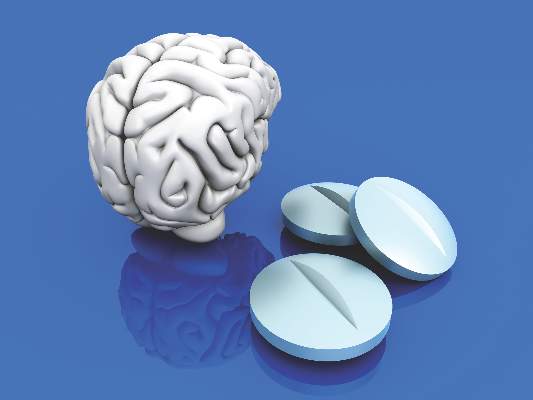User login
Drug targeting Huntington’s disease–causing protein undergoing clinical trial
A drug that was found to have no dose-limiting side effects in nonhuman primates is being evaluated in a clinical trial for its ability to reduce production of the protein that causes Huntington’s disease (HD).
The new drug, which is an antisense oligonucleotide, was formerly known as ISIS-HTTRx and was renamed IONIS-HTTRx, because its developer changed its name in December 2015 to Ionis Pharmaceuticals from Isis Pharmaceuticals. IONIS-HTTRx acts as a gene silencer to inhibit the production of huntington protein in people with HD. The clinical trial now underway is a randomized, double-blind, placebo-controlled study aimed at evaluating the safety, tolerability, pharmacokinetics, and pharmacodynamics of multiple ascending doses of IONIS-HTTRx in up to 36 patients with early manifest HD. If the trial is successful, IONIS-HTTRx would be the first drug to modify HD progression in patients, according to an abstract to be presented at the annual meeting of the American Academy of Neurology in Vancouver in April.
Ionis found the drug to be well tolerated in rodents and nonhuman primates in investigational new drug-enabling toxicology studies, with nonhuman primates having received doses up to 20 mg of the drug intrathecally, according to the trial’s principal investigator Dr. Blair R. Leavitt of the University of British Columbia, Vancouver, and colleagues.
“It is very exciting to have the possibility of a treatment that could alter the course of this devastating disease. Right now we only have treatments that work on the symptoms of the disease.” Dr. Leavitt said in a written statement.
The study is supported by Ionis Pharmaceuticals and is part of Ionis’ collaboration with Roche to develop antisense drugs to treat HD, according to the investigators.
A drug that was found to have no dose-limiting side effects in nonhuman primates is being evaluated in a clinical trial for its ability to reduce production of the protein that causes Huntington’s disease (HD).
The new drug, which is an antisense oligonucleotide, was formerly known as ISIS-HTTRx and was renamed IONIS-HTTRx, because its developer changed its name in December 2015 to Ionis Pharmaceuticals from Isis Pharmaceuticals. IONIS-HTTRx acts as a gene silencer to inhibit the production of huntington protein in people with HD. The clinical trial now underway is a randomized, double-blind, placebo-controlled study aimed at evaluating the safety, tolerability, pharmacokinetics, and pharmacodynamics of multiple ascending doses of IONIS-HTTRx in up to 36 patients with early manifest HD. If the trial is successful, IONIS-HTTRx would be the first drug to modify HD progression in patients, according to an abstract to be presented at the annual meeting of the American Academy of Neurology in Vancouver in April.
Ionis found the drug to be well tolerated in rodents and nonhuman primates in investigational new drug-enabling toxicology studies, with nonhuman primates having received doses up to 20 mg of the drug intrathecally, according to the trial’s principal investigator Dr. Blair R. Leavitt of the University of British Columbia, Vancouver, and colleagues.
“It is very exciting to have the possibility of a treatment that could alter the course of this devastating disease. Right now we only have treatments that work on the symptoms of the disease.” Dr. Leavitt said in a written statement.
The study is supported by Ionis Pharmaceuticals and is part of Ionis’ collaboration with Roche to develop antisense drugs to treat HD, according to the investigators.
A drug that was found to have no dose-limiting side effects in nonhuman primates is being evaluated in a clinical trial for its ability to reduce production of the protein that causes Huntington’s disease (HD).
The new drug, which is an antisense oligonucleotide, was formerly known as ISIS-HTTRx and was renamed IONIS-HTTRx, because its developer changed its name in December 2015 to Ionis Pharmaceuticals from Isis Pharmaceuticals. IONIS-HTTRx acts as a gene silencer to inhibit the production of huntington protein in people with HD. The clinical trial now underway is a randomized, double-blind, placebo-controlled study aimed at evaluating the safety, tolerability, pharmacokinetics, and pharmacodynamics of multiple ascending doses of IONIS-HTTRx in up to 36 patients with early manifest HD. If the trial is successful, IONIS-HTTRx would be the first drug to modify HD progression in patients, according to an abstract to be presented at the annual meeting of the American Academy of Neurology in Vancouver in April.
Ionis found the drug to be well tolerated in rodents and nonhuman primates in investigational new drug-enabling toxicology studies, with nonhuman primates having received doses up to 20 mg of the drug intrathecally, according to the trial’s principal investigator Dr. Blair R. Leavitt of the University of British Columbia, Vancouver, and colleagues.
“It is very exciting to have the possibility of a treatment that could alter the course of this devastating disease. Right now we only have treatments that work on the symptoms of the disease.” Dr. Leavitt said in a written statement.
The study is supported by Ionis Pharmaceuticals and is part of Ionis’ collaboration with Roche to develop antisense drugs to treat HD, according to the investigators.
Donor human milk availability to VLBW infants associated with decreased NEC
For very low birth weight infants, the availability of donor human milk to newborns was associated with a decreased incidence of necrotizing enterocolitis and an increased rate of breastfeeding at discharge from a neonatal intensive care unit.
The researchers based their findings on data obtained from the California Perinatal Quality Care Collaborative, which gathers information on the care of greater than 90% of California’s neonatal intensive care unit (NICU) admissions of very low birth weight (VLBW) infants (defined as weighing less than or equal to 1.5 kg at birth), and the Mother’s Milk Bank of San Jose, a human milk bank serving 94 hospitals across several states, including California. All of the data was collected between 2007 and 2013 in over 42,000 VLBW babies. Babies were classified as breastfeeding at discharge, if they were feeding with human milk or human milk with fortifier or formula, but not if they were only feeding with formula.
Agata Kantorowska, a medical student at the University of Rochester (N.Y.) School of Medicine and Dentistry, and her colleagues noted that they did not know if donor human milk (DHM) was used primarily as a back-up feeding if mother’s milk was unavailable, in another way, or in conjunction with human milk-derived fortifiers; the proportion of VLBW infants within each NICU that received DHM; or the length of time that an individual received DHM.
Among the 22 hospitals studied that went from not having DHM available to making it available, on average, the rate of breastfeeding at discharge increased by 10% after DHM became available (P less than .0001). Among these same hospitals, the mean change in necrotizing enterocolitis (NEC) prevalence, following the introduction of DHM, was a 2.6% decrease (P = .0006). Before DHM became available in the 22 hospitals, 52.8% of VLBW infants were breastfeeding at discharge, compared with 61.7% after DHM became available. The rate of NEC was 6.6% among VLBW infants prior to DHM having becoming available at a hospital, versus 4.3% following the introduction of DHM to a hospital.
Following risk adjustment, not having DHM available in a hospital was a negative predictor for breastfeeding at discharge (odds ratio, 0.70) and a positive predictor of NEC (odds ratio, 1.15).
Ms. Kantorowska and her associates said while they found “a significant association between a hospital’s DHM status and increased breastfeeding and decreased NEC rates among VLBW infants,” factors other than the availability of DHM contributed to changes in breastfeeding and NEC rates that occurred. They also noted that they saw an increased rate of breastfeeding and a similar decreasing rate of NEC in hospitals that did not transition to using DHM.
“Societal attitudes toward breastfeeding are likely influencing mothers’ attempts to provide breast milk to their VLBW infants. ... The NICU battle against NEC is ongoing, and other advances in care that occurred from 2007 to 2013 could be contributing to the observed decrease in NEC rate in hospitals that acquired DHM,” the researchers said.
Read the full study in Pediatrics (doi: 10.1542/peds.2015-3123).
For very low birth weight infants, the availability of donor human milk to newborns was associated with a decreased incidence of necrotizing enterocolitis and an increased rate of breastfeeding at discharge from a neonatal intensive care unit.
The researchers based their findings on data obtained from the California Perinatal Quality Care Collaborative, which gathers information on the care of greater than 90% of California’s neonatal intensive care unit (NICU) admissions of very low birth weight (VLBW) infants (defined as weighing less than or equal to 1.5 kg at birth), and the Mother’s Milk Bank of San Jose, a human milk bank serving 94 hospitals across several states, including California. All of the data was collected between 2007 and 2013 in over 42,000 VLBW babies. Babies were classified as breastfeeding at discharge, if they were feeding with human milk or human milk with fortifier or formula, but not if they were only feeding with formula.
Agata Kantorowska, a medical student at the University of Rochester (N.Y.) School of Medicine and Dentistry, and her colleagues noted that they did not know if donor human milk (DHM) was used primarily as a back-up feeding if mother’s milk was unavailable, in another way, or in conjunction with human milk-derived fortifiers; the proportion of VLBW infants within each NICU that received DHM; or the length of time that an individual received DHM.
Among the 22 hospitals studied that went from not having DHM available to making it available, on average, the rate of breastfeeding at discharge increased by 10% after DHM became available (P less than .0001). Among these same hospitals, the mean change in necrotizing enterocolitis (NEC) prevalence, following the introduction of DHM, was a 2.6% decrease (P = .0006). Before DHM became available in the 22 hospitals, 52.8% of VLBW infants were breastfeeding at discharge, compared with 61.7% after DHM became available. The rate of NEC was 6.6% among VLBW infants prior to DHM having becoming available at a hospital, versus 4.3% following the introduction of DHM to a hospital.
Following risk adjustment, not having DHM available in a hospital was a negative predictor for breastfeeding at discharge (odds ratio, 0.70) and a positive predictor of NEC (odds ratio, 1.15).
Ms. Kantorowska and her associates said while they found “a significant association between a hospital’s DHM status and increased breastfeeding and decreased NEC rates among VLBW infants,” factors other than the availability of DHM contributed to changes in breastfeeding and NEC rates that occurred. They also noted that they saw an increased rate of breastfeeding and a similar decreasing rate of NEC in hospitals that did not transition to using DHM.
“Societal attitudes toward breastfeeding are likely influencing mothers’ attempts to provide breast milk to their VLBW infants. ... The NICU battle against NEC is ongoing, and other advances in care that occurred from 2007 to 2013 could be contributing to the observed decrease in NEC rate in hospitals that acquired DHM,” the researchers said.
Read the full study in Pediatrics (doi: 10.1542/peds.2015-3123).
For very low birth weight infants, the availability of donor human milk to newborns was associated with a decreased incidence of necrotizing enterocolitis and an increased rate of breastfeeding at discharge from a neonatal intensive care unit.
The researchers based their findings on data obtained from the California Perinatal Quality Care Collaborative, which gathers information on the care of greater than 90% of California’s neonatal intensive care unit (NICU) admissions of very low birth weight (VLBW) infants (defined as weighing less than or equal to 1.5 kg at birth), and the Mother’s Milk Bank of San Jose, a human milk bank serving 94 hospitals across several states, including California. All of the data was collected between 2007 and 2013 in over 42,000 VLBW babies. Babies were classified as breastfeeding at discharge, if they were feeding with human milk or human milk with fortifier or formula, but not if they were only feeding with formula.
Agata Kantorowska, a medical student at the University of Rochester (N.Y.) School of Medicine and Dentistry, and her colleagues noted that they did not know if donor human milk (DHM) was used primarily as a back-up feeding if mother’s milk was unavailable, in another way, or in conjunction with human milk-derived fortifiers; the proportion of VLBW infants within each NICU that received DHM; or the length of time that an individual received DHM.
Among the 22 hospitals studied that went from not having DHM available to making it available, on average, the rate of breastfeeding at discharge increased by 10% after DHM became available (P less than .0001). Among these same hospitals, the mean change in necrotizing enterocolitis (NEC) prevalence, following the introduction of DHM, was a 2.6% decrease (P = .0006). Before DHM became available in the 22 hospitals, 52.8% of VLBW infants were breastfeeding at discharge, compared with 61.7% after DHM became available. The rate of NEC was 6.6% among VLBW infants prior to DHM having becoming available at a hospital, versus 4.3% following the introduction of DHM to a hospital.
Following risk adjustment, not having DHM available in a hospital was a negative predictor for breastfeeding at discharge (odds ratio, 0.70) and a positive predictor of NEC (odds ratio, 1.15).
Ms. Kantorowska and her associates said while they found “a significant association between a hospital’s DHM status and increased breastfeeding and decreased NEC rates among VLBW infants,” factors other than the availability of DHM contributed to changes in breastfeeding and NEC rates that occurred. They also noted that they saw an increased rate of breastfeeding and a similar decreasing rate of NEC in hospitals that did not transition to using DHM.
“Societal attitudes toward breastfeeding are likely influencing mothers’ attempts to provide breast milk to their VLBW infants. ... The NICU battle against NEC is ongoing, and other advances in care that occurred from 2007 to 2013 could be contributing to the observed decrease in NEC rate in hospitals that acquired DHM,” the researchers said.
Read the full study in Pediatrics (doi: 10.1542/peds.2015-3123).
FROM PEDIATRICS
Gender identity disorders in males associated with MS
An association between gender identity disorders (GIDs) and subsequent multiple sclerosis (MS) in males was found in an analysis of linked English Hospital Episode Statistics and mortality data from January 1999 to March 2012.
The findings “suggest that low testosterone levels and/or feminising gonadal hormones might influence MS risk in some men and highlight a need for further work to explore any potential role for gonadal hormones in management and/or prevention strategies,” wrote Dr. Julia Pakpoor of the Unit of Health-Care Epidemiology, Nuffield Department of Population Health, at University of Oxford (England).
She and her colleagues used the patient data to construct male and female cohorts (1,157 patients and 2,390 patients, respectively) of patients with GIDs. A patient was included in one of the two GID cohorts if he or she had an episode of care or hospital admission in which a GID or sexual transformation procedure was coded in any diagnostic position.
For males with GIDs transitioning to females, the most studied treatment regimen involves using feminizing hormones and anti-androgens, which reduce testosterone secretion or neutralize testosterone activity, the researchers noted.
They also used the database to construct male and female cohorts (4.6 million patients and 3.4 million patients, respectively) to serve as two control groups. For patients to be included in the control groups, they needed to have been first admitted to a hospital for a minor condition and to never have been admitted to a hospital for MS. Patients who had been admitted to a hospital for MS either before or at the same time they were admitted for GIDs were excluded from the GID cohorts. A patient stopped being followed upon diagnosis with MS.
“Our study design cannot give insights into mechanisms that might explain the association [between males with GIDs and MS]. However, there is evidence suggesting an association between gonadal hormones and MS, including animal models suggesting anti-inflammatory and/or neuroprotective actions of testosterone, studies indicating a high prevalence of hypogonadism in male MS patients, and improved cognitive function and slowed brain atrophy in a small pilot trial of testosterone,” the researchers noted.
The adjusted rate ratio of MS following GID in males was 6.63 (P = .0002), compared with 1.44 in females (P = .58). The adjusted rate ratios were based on 4 observed cases and 0.6 expected cases of MS in males and 5 observed cases and 3.5 expected cases of MS in females.
The authors reported no conflicts of interest.
Read the study in Multiple Sclerosis Journal (doi: 10.1177/1352458515627205).
An association between gender identity disorders (GIDs) and subsequent multiple sclerosis (MS) in males was found in an analysis of linked English Hospital Episode Statistics and mortality data from January 1999 to March 2012.
The findings “suggest that low testosterone levels and/or feminising gonadal hormones might influence MS risk in some men and highlight a need for further work to explore any potential role for gonadal hormones in management and/or prevention strategies,” wrote Dr. Julia Pakpoor of the Unit of Health-Care Epidemiology, Nuffield Department of Population Health, at University of Oxford (England).
She and her colleagues used the patient data to construct male and female cohorts (1,157 patients and 2,390 patients, respectively) of patients with GIDs. A patient was included in one of the two GID cohorts if he or she had an episode of care or hospital admission in which a GID or sexual transformation procedure was coded in any diagnostic position.
For males with GIDs transitioning to females, the most studied treatment regimen involves using feminizing hormones and anti-androgens, which reduce testosterone secretion or neutralize testosterone activity, the researchers noted.
They also used the database to construct male and female cohorts (4.6 million patients and 3.4 million patients, respectively) to serve as two control groups. For patients to be included in the control groups, they needed to have been first admitted to a hospital for a minor condition and to never have been admitted to a hospital for MS. Patients who had been admitted to a hospital for MS either before or at the same time they were admitted for GIDs were excluded from the GID cohorts. A patient stopped being followed upon diagnosis with MS.
“Our study design cannot give insights into mechanisms that might explain the association [between males with GIDs and MS]. However, there is evidence suggesting an association between gonadal hormones and MS, including animal models suggesting anti-inflammatory and/or neuroprotective actions of testosterone, studies indicating a high prevalence of hypogonadism in male MS patients, and improved cognitive function and slowed brain atrophy in a small pilot trial of testosterone,” the researchers noted.
The adjusted rate ratio of MS following GID in males was 6.63 (P = .0002), compared with 1.44 in females (P = .58). The adjusted rate ratios were based on 4 observed cases and 0.6 expected cases of MS in males and 5 observed cases and 3.5 expected cases of MS in females.
The authors reported no conflicts of interest.
Read the study in Multiple Sclerosis Journal (doi: 10.1177/1352458515627205).
An association between gender identity disorders (GIDs) and subsequent multiple sclerosis (MS) in males was found in an analysis of linked English Hospital Episode Statistics and mortality data from January 1999 to March 2012.
The findings “suggest that low testosterone levels and/or feminising gonadal hormones might influence MS risk in some men and highlight a need for further work to explore any potential role for gonadal hormones in management and/or prevention strategies,” wrote Dr. Julia Pakpoor of the Unit of Health-Care Epidemiology, Nuffield Department of Population Health, at University of Oxford (England).
She and her colleagues used the patient data to construct male and female cohorts (1,157 patients and 2,390 patients, respectively) of patients with GIDs. A patient was included in one of the two GID cohorts if he or she had an episode of care or hospital admission in which a GID or sexual transformation procedure was coded in any diagnostic position.
For males with GIDs transitioning to females, the most studied treatment regimen involves using feminizing hormones and anti-androgens, which reduce testosterone secretion or neutralize testosterone activity, the researchers noted.
They also used the database to construct male and female cohorts (4.6 million patients and 3.4 million patients, respectively) to serve as two control groups. For patients to be included in the control groups, they needed to have been first admitted to a hospital for a minor condition and to never have been admitted to a hospital for MS. Patients who had been admitted to a hospital for MS either before or at the same time they were admitted for GIDs were excluded from the GID cohorts. A patient stopped being followed upon diagnosis with MS.
“Our study design cannot give insights into mechanisms that might explain the association [between males with GIDs and MS]. However, there is evidence suggesting an association between gonadal hormones and MS, including animal models suggesting anti-inflammatory and/or neuroprotective actions of testosterone, studies indicating a high prevalence of hypogonadism in male MS patients, and improved cognitive function and slowed brain atrophy in a small pilot trial of testosterone,” the researchers noted.
The adjusted rate ratio of MS following GID in males was 6.63 (P = .0002), compared with 1.44 in females (P = .58). The adjusted rate ratios were based on 4 observed cases and 0.6 expected cases of MS in males and 5 observed cases and 3.5 expected cases of MS in females.
The authors reported no conflicts of interest.
Read the study in Multiple Sclerosis Journal (doi: 10.1177/1352458515627205).
FROM MULTIPLE SCLEROSIS JOURNAL
Use preventive strategies to lower cardiovascular risks in bipolar I
The significantly increased risk of myocardial infarction or stroke in patients with bipolar I disorder appears to be tied more to preventive factors than to cardiovascular risk factors. However, bipolar I patients with a history of psychosis have an marginally increased risk of MI or stroke, a population-based cohort study showed.
The researchers came to those conclusions after analyzing residents’ health records and death certificates in Olmsted County, Minn., which were contained within the Rochester Epidemiology Project database. The study’s participants included 334 patients with bipolar I disorder and 334 people without bipolar disorder, although one of the patients who did not have bipolar I at the beginning of the study was later diagnosed with the disorder. All participants had been residents of Olmsted County from Jan. 1, 1966, through Dec. 31,1996.
Patients continued to be followed until Dec. 31, 2013, unless one of the following events occurred before that date: the patient had an MI or stroke, was lost to follow-up, or died before the end of the study. A patient experiencing an MI, stroke, or death or a patient disappearing from the database triggered an end to that patient’s participation in the study.
When an individual having an MI or a stroke was treated as a composite outcome, bipolar I disorder patients had a significantly increased risk of experiencing a fatal or non-fatal MI or stroke, compared with the individuals in the control group (P = .04). The risk was no longer significant after the researchers adjusted for the following potential baseline confounders of the association between bipolar disorder and cardiovascular disease: alcohol use disorder, diabetes, hypertension, and smoking (P = .46).
Meanwhile, a secondary analysis of the data showed that history of psychosis was indeed tied to a marginally increased risk of MI or stroke (P =.06).
“It will be fundamental to improve current preventive strategies to decrease the prevalence of smoking, alcohol use, hypertension, and diabetes among patients with bipolar disorder,” said Dr. Miguel L. Prieto of the department of psychiatry and psychology at the Mayo Medical School, Rochester, Minn., and his colleagues. “Moreover, we detected a possible higher risk of MI/stroke in the subgroup of patients with history of psychosis that certainly warrants replication.”
Future research also should seek to determine early biomarkers of atherosclerosis, the researchers said.
Read the study in Journal of Affective Disorders (doi: 10.1016/j.jad.2016.01.015).
The significantly increased risk of myocardial infarction or stroke in patients with bipolar I disorder appears to be tied more to preventive factors than to cardiovascular risk factors. However, bipolar I patients with a history of psychosis have an marginally increased risk of MI or stroke, a population-based cohort study showed.
The researchers came to those conclusions after analyzing residents’ health records and death certificates in Olmsted County, Minn., which were contained within the Rochester Epidemiology Project database. The study’s participants included 334 patients with bipolar I disorder and 334 people without bipolar disorder, although one of the patients who did not have bipolar I at the beginning of the study was later diagnosed with the disorder. All participants had been residents of Olmsted County from Jan. 1, 1966, through Dec. 31,1996.
Patients continued to be followed until Dec. 31, 2013, unless one of the following events occurred before that date: the patient had an MI or stroke, was lost to follow-up, or died before the end of the study. A patient experiencing an MI, stroke, or death or a patient disappearing from the database triggered an end to that patient’s participation in the study.
When an individual having an MI or a stroke was treated as a composite outcome, bipolar I disorder patients had a significantly increased risk of experiencing a fatal or non-fatal MI or stroke, compared with the individuals in the control group (P = .04). The risk was no longer significant after the researchers adjusted for the following potential baseline confounders of the association between bipolar disorder and cardiovascular disease: alcohol use disorder, diabetes, hypertension, and smoking (P = .46).
Meanwhile, a secondary analysis of the data showed that history of psychosis was indeed tied to a marginally increased risk of MI or stroke (P =.06).
“It will be fundamental to improve current preventive strategies to decrease the prevalence of smoking, alcohol use, hypertension, and diabetes among patients with bipolar disorder,” said Dr. Miguel L. Prieto of the department of psychiatry and psychology at the Mayo Medical School, Rochester, Minn., and his colleagues. “Moreover, we detected a possible higher risk of MI/stroke in the subgroup of patients with history of psychosis that certainly warrants replication.”
Future research also should seek to determine early biomarkers of atherosclerosis, the researchers said.
Read the study in Journal of Affective Disorders (doi: 10.1016/j.jad.2016.01.015).
The significantly increased risk of myocardial infarction or stroke in patients with bipolar I disorder appears to be tied more to preventive factors than to cardiovascular risk factors. However, bipolar I patients with a history of psychosis have an marginally increased risk of MI or stroke, a population-based cohort study showed.
The researchers came to those conclusions after analyzing residents’ health records and death certificates in Olmsted County, Minn., which were contained within the Rochester Epidemiology Project database. The study’s participants included 334 patients with bipolar I disorder and 334 people without bipolar disorder, although one of the patients who did not have bipolar I at the beginning of the study was later diagnosed with the disorder. All participants had been residents of Olmsted County from Jan. 1, 1966, through Dec. 31,1996.
Patients continued to be followed until Dec. 31, 2013, unless one of the following events occurred before that date: the patient had an MI or stroke, was lost to follow-up, or died before the end of the study. A patient experiencing an MI, stroke, or death or a patient disappearing from the database triggered an end to that patient’s participation in the study.
When an individual having an MI or a stroke was treated as a composite outcome, bipolar I disorder patients had a significantly increased risk of experiencing a fatal or non-fatal MI or stroke, compared with the individuals in the control group (P = .04). The risk was no longer significant after the researchers adjusted for the following potential baseline confounders of the association between bipolar disorder and cardiovascular disease: alcohol use disorder, diabetes, hypertension, and smoking (P = .46).
Meanwhile, a secondary analysis of the data showed that history of psychosis was indeed tied to a marginally increased risk of MI or stroke (P =.06).
“It will be fundamental to improve current preventive strategies to decrease the prevalence of smoking, alcohol use, hypertension, and diabetes among patients with bipolar disorder,” said Dr. Miguel L. Prieto of the department of psychiatry and psychology at the Mayo Medical School, Rochester, Minn., and his colleagues. “Moreover, we detected a possible higher risk of MI/stroke in the subgroup of patients with history of psychosis that certainly warrants replication.”
Future research also should seek to determine early biomarkers of atherosclerosis, the researchers said.
Read the study in Journal of Affective Disorders (doi: 10.1016/j.jad.2016.01.015).
FROM JOURNAL OF AFFECTIVE DISORDERS
NIDA releases strategic plan to prevent, treat substance use disorders
The National Institute on Drug Abuse (NIDA) has developed a 5-year strategic plan aimed at gaining new information about the basic science of the brain as it relates to the causes and consequences of drug use and addiction. Part of the plan is to use novel findings about the brain to create more effective interventions for preventing and treating substance use disorders, according to a written statement by NIDA.
The plan for 2016-2020, which NIDA has named “Advancing Addiction Science,” calls for the achievement of the following four strategic goals:
• Identify the biological, environmental, behavioral, and social causes and consequences of drug use and addiction across the lifespan.
• Develop improved strategies to prevent drug use and its consequences.
• Develop new and improved treatments to help people with substance use disorders achieve and maintain a meaningful and sustained recovery.
• Increase the public health impact of NIDA research and programs.
“Developing this plan was a collaborative effort incorporating guidance from the National Advisory Council on Drug Abuse, scientific and clinical experts, stakeholder organizations, and the public,” NIDA Director Nora Volkow said in a written statement.
“This plan outlines our broad goals across basic science, prevention, treatment, and public health; identifies four priority focus areas that we believe present unique opportunities to be leveraged over the next 5 years; and reflects a flexible, dynamic approach that will allow us to adapt to new scientific and technological advances and changing public health needs, and to take advantage of scientific opportunities as they arise,” she said.
More information about the plan is available here.
The National Institute on Drug Abuse (NIDA) has developed a 5-year strategic plan aimed at gaining new information about the basic science of the brain as it relates to the causes and consequences of drug use and addiction. Part of the plan is to use novel findings about the brain to create more effective interventions for preventing and treating substance use disorders, according to a written statement by NIDA.
The plan for 2016-2020, which NIDA has named “Advancing Addiction Science,” calls for the achievement of the following four strategic goals:
• Identify the biological, environmental, behavioral, and social causes and consequences of drug use and addiction across the lifespan.
• Develop improved strategies to prevent drug use and its consequences.
• Develop new and improved treatments to help people with substance use disorders achieve and maintain a meaningful and sustained recovery.
• Increase the public health impact of NIDA research and programs.
“Developing this plan was a collaborative effort incorporating guidance from the National Advisory Council on Drug Abuse, scientific and clinical experts, stakeholder organizations, and the public,” NIDA Director Nora Volkow said in a written statement.
“This plan outlines our broad goals across basic science, prevention, treatment, and public health; identifies four priority focus areas that we believe present unique opportunities to be leveraged over the next 5 years; and reflects a flexible, dynamic approach that will allow us to adapt to new scientific and technological advances and changing public health needs, and to take advantage of scientific opportunities as they arise,” she said.
More information about the plan is available here.
The National Institute on Drug Abuse (NIDA) has developed a 5-year strategic plan aimed at gaining new information about the basic science of the brain as it relates to the causes and consequences of drug use and addiction. Part of the plan is to use novel findings about the brain to create more effective interventions for preventing and treating substance use disorders, according to a written statement by NIDA.
The plan for 2016-2020, which NIDA has named “Advancing Addiction Science,” calls for the achievement of the following four strategic goals:
• Identify the biological, environmental, behavioral, and social causes and consequences of drug use and addiction across the lifespan.
• Develop improved strategies to prevent drug use and its consequences.
• Develop new and improved treatments to help people with substance use disorders achieve and maintain a meaningful and sustained recovery.
• Increase the public health impact of NIDA research and programs.
“Developing this plan was a collaborative effort incorporating guidance from the National Advisory Council on Drug Abuse, scientific and clinical experts, stakeholder organizations, and the public,” NIDA Director Nora Volkow said in a written statement.
“This plan outlines our broad goals across basic science, prevention, treatment, and public health; identifies four priority focus areas that we believe present unique opportunities to be leveraged over the next 5 years; and reflects a flexible, dynamic approach that will allow us to adapt to new scientific and technological advances and changing public health needs, and to take advantage of scientific opportunities as they arise,” she said.
More information about the plan is available here.
Childhood Metabolic Syndrome Severity Declined Relative to HDL, Triglyceride Changes
The severity of childhood metabolic syndrome declined in a study of U.S. adolescents relative to increases in high-density lipoproteins (HDL) and decreases in fasting triglyceride measurements among the individuals examined, reported Arthur M. Lee of the University of Virginia, Charlottesville, and his colleagues.
The metabolic syndrome (MetS) is characterized by central obesity, high fasting glucose, high fasting triglycerides, high blood pressure (BP), and low HDL.
The researchers used regression analysis of individual waves of data from 1999 to 2012 to analyze 5,117 individuals aged 12-19 years. The data came from the Centers for Disease Control and Prevention National Health and Nutrition Examination Survey (NHANES, 1999-2012), a cross-sectional, national, stratified, multistage probability survey conducted in 2-year waves. The severity of MetS was calculated using the Pediatric MetS z score. Patients who were pregnant, had an active hepatitis B infection, had physician-diagnosed diabetes, or were currently using antidiabetic or antihyperlipidemic medication were excluded from the study.
Overall, a linear trend of a decreasing MetS z score (P = .030) was found despite the body mass index z score having increased significantly. While fasting triglyceride measurements declined significantly, HDL levels rose significantly.
The researchers also found temporal trends of decreasing total calorie consumption, decreasing carbohydrate consumption, and increasing unsaturated fat consumption.
“The overall decreasing trend in the MetS z score is likely secondary to the increasing trend in HDL measurements and decreasing trend in fasting triglycerides measurements, ” wrote Mr. Lee and his associates. “The increasing trend in HDL and decreasing fasting triglyceride measurements could be attributable in part to trends of decreasing carbohydrate intake and increasing unsaturated fat intake.”
The researchers recommended future studies on individuals with MetS focus on determining, “the causality of lifestyle factors in improvements of MetS severity.”
Read the study in Pediatrics (doi: 10.1542/peds.2015-3177).
The severity of childhood metabolic syndrome declined in a study of U.S. adolescents relative to increases in high-density lipoproteins (HDL) and decreases in fasting triglyceride measurements among the individuals examined, reported Arthur M. Lee of the University of Virginia, Charlottesville, and his colleagues.
The metabolic syndrome (MetS) is characterized by central obesity, high fasting glucose, high fasting triglycerides, high blood pressure (BP), and low HDL.
The researchers used regression analysis of individual waves of data from 1999 to 2012 to analyze 5,117 individuals aged 12-19 years. The data came from the Centers for Disease Control and Prevention National Health and Nutrition Examination Survey (NHANES, 1999-2012), a cross-sectional, national, stratified, multistage probability survey conducted in 2-year waves. The severity of MetS was calculated using the Pediatric MetS z score. Patients who were pregnant, had an active hepatitis B infection, had physician-diagnosed diabetes, or were currently using antidiabetic or antihyperlipidemic medication were excluded from the study.
Overall, a linear trend of a decreasing MetS z score (P = .030) was found despite the body mass index z score having increased significantly. While fasting triglyceride measurements declined significantly, HDL levels rose significantly.
The researchers also found temporal trends of decreasing total calorie consumption, decreasing carbohydrate consumption, and increasing unsaturated fat consumption.
“The overall decreasing trend in the MetS z score is likely secondary to the increasing trend in HDL measurements and decreasing trend in fasting triglycerides measurements, ” wrote Mr. Lee and his associates. “The increasing trend in HDL and decreasing fasting triglyceride measurements could be attributable in part to trends of decreasing carbohydrate intake and increasing unsaturated fat intake.”
The researchers recommended future studies on individuals with MetS focus on determining, “the causality of lifestyle factors in improvements of MetS severity.”
Read the study in Pediatrics (doi: 10.1542/peds.2015-3177).
The severity of childhood metabolic syndrome declined in a study of U.S. adolescents relative to increases in high-density lipoproteins (HDL) and decreases in fasting triglyceride measurements among the individuals examined, reported Arthur M. Lee of the University of Virginia, Charlottesville, and his colleagues.
The metabolic syndrome (MetS) is characterized by central obesity, high fasting glucose, high fasting triglycerides, high blood pressure (BP), and low HDL.
The researchers used regression analysis of individual waves of data from 1999 to 2012 to analyze 5,117 individuals aged 12-19 years. The data came from the Centers for Disease Control and Prevention National Health and Nutrition Examination Survey (NHANES, 1999-2012), a cross-sectional, national, stratified, multistage probability survey conducted in 2-year waves. The severity of MetS was calculated using the Pediatric MetS z score. Patients who were pregnant, had an active hepatitis B infection, had physician-diagnosed diabetes, or were currently using antidiabetic or antihyperlipidemic medication were excluded from the study.
Overall, a linear trend of a decreasing MetS z score (P = .030) was found despite the body mass index z score having increased significantly. While fasting triglyceride measurements declined significantly, HDL levels rose significantly.
The researchers also found temporal trends of decreasing total calorie consumption, decreasing carbohydrate consumption, and increasing unsaturated fat consumption.
“The overall decreasing trend in the MetS z score is likely secondary to the increasing trend in HDL measurements and decreasing trend in fasting triglycerides measurements, ” wrote Mr. Lee and his associates. “The increasing trend in HDL and decreasing fasting triglyceride measurements could be attributable in part to trends of decreasing carbohydrate intake and increasing unsaturated fat intake.”
The researchers recommended future studies on individuals with MetS focus on determining, “the causality of lifestyle factors in improvements of MetS severity.”
Read the study in Pediatrics (doi: 10.1542/peds.2015-3177).
FROM PEDIATRICS
Childhood metabolic syndrome severity declined relative to HDL, triglyceride changes
The severity of childhood metabolic syndrome declined in a study of U.S. adolescents relative to increases in high-density lipoproteins (HDL) and decreases in fasting triglyceride measurements among the individuals examined, reported Arthur M. Lee of the University of Virginia, Charlottesville, and his colleagues.
The metabolic syndrome (MetS) is characterized by central obesity, high fasting glucose, high fasting triglycerides, high blood pressure (BP), and low HDL.
The researchers used regression analysis of individual waves of data from 1999 to 2012 to analyze 5,117 individuals aged 12-19 years. The data came from the Centers for Disease Control and Prevention National Health and Nutrition Examination Survey (NHANES, 1999-2012), a cross-sectional, national, stratified, multistage probability survey conducted in 2-year waves. The severity of MetS was calculated using the Pediatric MetS z score. Patients who were pregnant, had an active hepatitis B infection, had physician-diagnosed diabetes, or were currently using antidiabetic or antihyperlipidemic medication were excluded from the study.
Overall, a linear trend of a decreasing MetS z score (P = .030) was found despite the body mass index z score having increased significantly. While fasting triglyceride measurements declined significantly, HDL levels rose significantly.
The researchers also found temporal trends of decreasing total calorie consumption, decreasing carbohydrate consumption, and increasing unsaturated fat consumption.
“The overall decreasing trend in the MetS z score is likely secondary to the increasing trend in HDL measurements and decreasing trend in fasting triglycerides measurements, ” wrote Mr. Lee and his associates. “The increasing trend in HDL and decreasing fasting triglyceride measurements could be attributable in part to trends of decreasing carbohydrate intake and increasing unsaturated fat intake.”
The researchers recommended future studies on individuals with MetS focus on determining, “the causality of lifestyle factors in improvements of MetS severity.”
Read the study in Pediatrics (doi: 10.1542/peds.2015-3177).
The severity of childhood metabolic syndrome declined in a study of U.S. adolescents relative to increases in high-density lipoproteins (HDL) and decreases in fasting triglyceride measurements among the individuals examined, reported Arthur M. Lee of the University of Virginia, Charlottesville, and his colleagues.
The metabolic syndrome (MetS) is characterized by central obesity, high fasting glucose, high fasting triglycerides, high blood pressure (BP), and low HDL.
The researchers used regression analysis of individual waves of data from 1999 to 2012 to analyze 5,117 individuals aged 12-19 years. The data came from the Centers for Disease Control and Prevention National Health and Nutrition Examination Survey (NHANES, 1999-2012), a cross-sectional, national, stratified, multistage probability survey conducted in 2-year waves. The severity of MetS was calculated using the Pediatric MetS z score. Patients who were pregnant, had an active hepatitis B infection, had physician-diagnosed diabetes, or were currently using antidiabetic or antihyperlipidemic medication were excluded from the study.
Overall, a linear trend of a decreasing MetS z score (P = .030) was found despite the body mass index z score having increased significantly. While fasting triglyceride measurements declined significantly, HDL levels rose significantly.
The researchers also found temporal trends of decreasing total calorie consumption, decreasing carbohydrate consumption, and increasing unsaturated fat consumption.
“The overall decreasing trend in the MetS z score is likely secondary to the increasing trend in HDL measurements and decreasing trend in fasting triglycerides measurements, ” wrote Mr. Lee and his associates. “The increasing trend in HDL and decreasing fasting triglyceride measurements could be attributable in part to trends of decreasing carbohydrate intake and increasing unsaturated fat intake.”
The researchers recommended future studies on individuals with MetS focus on determining, “the causality of lifestyle factors in improvements of MetS severity.”
Read the study in Pediatrics (doi: 10.1542/peds.2015-3177).
The severity of childhood metabolic syndrome declined in a study of U.S. adolescents relative to increases in high-density lipoproteins (HDL) and decreases in fasting triglyceride measurements among the individuals examined, reported Arthur M. Lee of the University of Virginia, Charlottesville, and his colleagues.
The metabolic syndrome (MetS) is characterized by central obesity, high fasting glucose, high fasting triglycerides, high blood pressure (BP), and low HDL.
The researchers used regression analysis of individual waves of data from 1999 to 2012 to analyze 5,117 individuals aged 12-19 years. The data came from the Centers for Disease Control and Prevention National Health and Nutrition Examination Survey (NHANES, 1999-2012), a cross-sectional, national, stratified, multistage probability survey conducted in 2-year waves. The severity of MetS was calculated using the Pediatric MetS z score. Patients who were pregnant, had an active hepatitis B infection, had physician-diagnosed diabetes, or were currently using antidiabetic or antihyperlipidemic medication were excluded from the study.
Overall, a linear trend of a decreasing MetS z score (P = .030) was found despite the body mass index z score having increased significantly. While fasting triglyceride measurements declined significantly, HDL levels rose significantly.
The researchers also found temporal trends of decreasing total calorie consumption, decreasing carbohydrate consumption, and increasing unsaturated fat consumption.
“The overall decreasing trend in the MetS z score is likely secondary to the increasing trend in HDL measurements and decreasing trend in fasting triglycerides measurements, ” wrote Mr. Lee and his associates. “The increasing trend in HDL and decreasing fasting triglyceride measurements could be attributable in part to trends of decreasing carbohydrate intake and increasing unsaturated fat intake.”
The researchers recommended future studies on individuals with MetS focus on determining, “the causality of lifestyle factors in improvements of MetS severity.”
Read the study in Pediatrics (doi: 10.1542/peds.2015-3177).
FROM PEDIATRICS
Benzodiazepines not causally related to increased dementia risk
Benzodiazepine use by elderly adults did not seem to be causally related to an increased risk for dementia and cognitive decline, in a prospective study.
The study included 3,434 individuals aged 65 years or older without dementia. For at least 10 years prior to enrollment in the study, all participants had been members of Group Health, an integrated health delivery system in the Northwest United States that maintains computerized pharmacy data, including names, strengths, dates dispensed, and amounts dispensed of drugs used by its members.
Thirty percent of participants had filled at least one prescription for a benzodiazepine in the 10 years before entering the study, with 3% of participants having used the drug within 6 months of study entry. The researchers categorized patients based on their level of use, with patients falling into the highest-use category having taken at least 121 total standardized daily doses (TSDDs). The median level of use within that group was 375 TSDDs, equivalent to slightly over a year of daily use.
In 2004, the study began continuous enrollment to replace those who developed dementia, died, or dropped out. Participants were assessed for cognitive function upon beginning participation in the study and every 2 years afterward. All participants were followed until the earliest onset of dementia, disenrollment from Group Health, or their last study visit before Sept. 30, 2012.
The researchers found no association between the use of benzodiazepines at the TSDD level defined as highest use in this study and dementia (hazard ratio, 1.07) or Alzheimer’s disease (HR, 0.95), compared with nonuse. “When we split the highest category of benzodiazepine use into two groups, the hazard ratio for dementia was 1.11 (0.78-1.58) for 121-364 TSDDs and 1.03 (0.73-1.44) for greater than or equal to 365 TSDDs. Findings for Alzheimer’s disease were similar,” said Shelly L. Gray, Pharm.D., professor of pharmacy at the University of Washington School of Pharmacy, Seattle, and her colleagues.
A slightly increased risk for dementia for study participants classified as low users (taking 1-30 TSDDs) or moderate users (taking 31-120 TSDDs) of benzodiazepine was found, when compared with nonusers. Low users of benzodiazepine were also at increased risk for Alzheimer’s disease (HR, 1.27).
“In conclusion, we found a slightly higher risk of dementia in people with the lowest benzodiazepine use but no increased risk in those with the highest level of exposure. … Overall, our pattern of findings does not support the theory that cumulative benzodiazepine use at the levels observed in our population is causally related to an increased risk for dementia or cognitive decline. … Nonetheless, given the mixed evidence regarding benzodiazepines and risk of dementia and that these drugs are associated with many adverse events, health care providers are still advised to avoid benzodiazepines in older adults to prevent important adverse health outcomes, withdrawal, and dependence,” according to the researchers.
Read the study in the BMJ (doi: 10.1136/bmj.i90).
Benzodiazepine use by elderly adults did not seem to be causally related to an increased risk for dementia and cognitive decline, in a prospective study.
The study included 3,434 individuals aged 65 years or older without dementia. For at least 10 years prior to enrollment in the study, all participants had been members of Group Health, an integrated health delivery system in the Northwest United States that maintains computerized pharmacy data, including names, strengths, dates dispensed, and amounts dispensed of drugs used by its members.
Thirty percent of participants had filled at least one prescription for a benzodiazepine in the 10 years before entering the study, with 3% of participants having used the drug within 6 months of study entry. The researchers categorized patients based on their level of use, with patients falling into the highest-use category having taken at least 121 total standardized daily doses (TSDDs). The median level of use within that group was 375 TSDDs, equivalent to slightly over a year of daily use.
In 2004, the study began continuous enrollment to replace those who developed dementia, died, or dropped out. Participants were assessed for cognitive function upon beginning participation in the study and every 2 years afterward. All participants were followed until the earliest onset of dementia, disenrollment from Group Health, or their last study visit before Sept. 30, 2012.
The researchers found no association between the use of benzodiazepines at the TSDD level defined as highest use in this study and dementia (hazard ratio, 1.07) or Alzheimer’s disease (HR, 0.95), compared with nonuse. “When we split the highest category of benzodiazepine use into two groups, the hazard ratio for dementia was 1.11 (0.78-1.58) for 121-364 TSDDs and 1.03 (0.73-1.44) for greater than or equal to 365 TSDDs. Findings for Alzheimer’s disease were similar,” said Shelly L. Gray, Pharm.D., professor of pharmacy at the University of Washington School of Pharmacy, Seattle, and her colleagues.
A slightly increased risk for dementia for study participants classified as low users (taking 1-30 TSDDs) or moderate users (taking 31-120 TSDDs) of benzodiazepine was found, when compared with nonusers. Low users of benzodiazepine were also at increased risk for Alzheimer’s disease (HR, 1.27).
“In conclusion, we found a slightly higher risk of dementia in people with the lowest benzodiazepine use but no increased risk in those with the highest level of exposure. … Overall, our pattern of findings does not support the theory that cumulative benzodiazepine use at the levels observed in our population is causally related to an increased risk for dementia or cognitive decline. … Nonetheless, given the mixed evidence regarding benzodiazepines and risk of dementia and that these drugs are associated with many adverse events, health care providers are still advised to avoid benzodiazepines in older adults to prevent important adverse health outcomes, withdrawal, and dependence,” according to the researchers.
Read the study in the BMJ (doi: 10.1136/bmj.i90).
Benzodiazepine use by elderly adults did not seem to be causally related to an increased risk for dementia and cognitive decline, in a prospective study.
The study included 3,434 individuals aged 65 years or older without dementia. For at least 10 years prior to enrollment in the study, all participants had been members of Group Health, an integrated health delivery system in the Northwest United States that maintains computerized pharmacy data, including names, strengths, dates dispensed, and amounts dispensed of drugs used by its members.
Thirty percent of participants had filled at least one prescription for a benzodiazepine in the 10 years before entering the study, with 3% of participants having used the drug within 6 months of study entry. The researchers categorized patients based on their level of use, with patients falling into the highest-use category having taken at least 121 total standardized daily doses (TSDDs). The median level of use within that group was 375 TSDDs, equivalent to slightly over a year of daily use.
In 2004, the study began continuous enrollment to replace those who developed dementia, died, or dropped out. Participants were assessed for cognitive function upon beginning participation in the study and every 2 years afterward. All participants were followed until the earliest onset of dementia, disenrollment from Group Health, or their last study visit before Sept. 30, 2012.
The researchers found no association between the use of benzodiazepines at the TSDD level defined as highest use in this study and dementia (hazard ratio, 1.07) or Alzheimer’s disease (HR, 0.95), compared with nonuse. “When we split the highest category of benzodiazepine use into two groups, the hazard ratio for dementia was 1.11 (0.78-1.58) for 121-364 TSDDs and 1.03 (0.73-1.44) for greater than or equal to 365 TSDDs. Findings for Alzheimer’s disease were similar,” said Shelly L. Gray, Pharm.D., professor of pharmacy at the University of Washington School of Pharmacy, Seattle, and her colleagues.
A slightly increased risk for dementia for study participants classified as low users (taking 1-30 TSDDs) or moderate users (taking 31-120 TSDDs) of benzodiazepine was found, when compared with nonusers. Low users of benzodiazepine were also at increased risk for Alzheimer’s disease (HR, 1.27).
“In conclusion, we found a slightly higher risk of dementia in people with the lowest benzodiazepine use but no increased risk in those with the highest level of exposure. … Overall, our pattern of findings does not support the theory that cumulative benzodiazepine use at the levels observed in our population is causally related to an increased risk for dementia or cognitive decline. … Nonetheless, given the mixed evidence regarding benzodiazepines and risk of dementia and that these drugs are associated with many adverse events, health care providers are still advised to avoid benzodiazepines in older adults to prevent important adverse health outcomes, withdrawal, and dependence,” according to the researchers.
Read the study in the BMJ (doi: 10.1136/bmj.i90).
FROM THE BMJ
Majority of children aged 6-23 months are not vaccinated for flu
Less than half of children aged 6-23 months are vaccinated for influenza in the United States, according to an analysis of data obtained via the 2003-2013 National Immunization Survey.
The researchers analyzed providers’ reports of influenza vaccinations, received as one or two doses by children aged 6-23 months. The age group studied is at highest risk of influenza-related complications and was the first group of children for which the Advisory Committee on Immunization Practices recommended influenza vaccination, regardless of an individual’s medical condition.
A child’s age was defined by his or her age on Nov. 1 of each influenza season under study. Two full calendar years of data files were combined to enable analysis of full influenza seasons, which cover parts of 2 consecutive calendar years. The percentages of children requiring two doses to be considered fully vaccinated were based on the dosage recommendations for each flu season.
Overall, flu vaccination coverage increased, reaching 45% in the 2011-2012 flu season, up from 5% during the 2002-2003 flu season. Within each racial/ethnic group examined, influenza vaccination coverage also grew; however, lower percentages of non-Hispanic black children and Hispanic children were vaccinated than of non-Hispanic white children during all 10 of the flu seasons studied. Coverage ranged from 24% in Mississippi to 72% in Massachusetts.
“Despite the increase, the majority of children 6-23 months in the United States were not fully vaccinated against influenza,” said Tammy A. Santibanez, Ph.D., of the Centers for Disease Control and Prevention, and her colleagues.
Among other findings consistent throughout each flu season examined was that full influenza vaccination coverage was higher among children requiring only one dose of a flu vaccine, compared with those requiring two doses of a flu vaccine.
“Prevention of influenza among infants and young children is a public health priority because of their high risk for influenza-related complications,” wrote Dr. Santibanez and her colleagues. “Appropriate implementation of evidence-based strategies is needed to increase the percentage of children who are fully vaccinated.”
Read the study in Pediatrics (doi: 10.1542/peds.2015.3280).
Less than half of children aged 6-23 months are vaccinated for influenza in the United States, according to an analysis of data obtained via the 2003-2013 National Immunization Survey.
The researchers analyzed providers’ reports of influenza vaccinations, received as one or two doses by children aged 6-23 months. The age group studied is at highest risk of influenza-related complications and was the first group of children for which the Advisory Committee on Immunization Practices recommended influenza vaccination, regardless of an individual’s medical condition.
A child’s age was defined by his or her age on Nov. 1 of each influenza season under study. Two full calendar years of data files were combined to enable analysis of full influenza seasons, which cover parts of 2 consecutive calendar years. The percentages of children requiring two doses to be considered fully vaccinated were based on the dosage recommendations for each flu season.
Overall, flu vaccination coverage increased, reaching 45% in the 2011-2012 flu season, up from 5% during the 2002-2003 flu season. Within each racial/ethnic group examined, influenza vaccination coverage also grew; however, lower percentages of non-Hispanic black children and Hispanic children were vaccinated than of non-Hispanic white children during all 10 of the flu seasons studied. Coverage ranged from 24% in Mississippi to 72% in Massachusetts.
“Despite the increase, the majority of children 6-23 months in the United States were not fully vaccinated against influenza,” said Tammy A. Santibanez, Ph.D., of the Centers for Disease Control and Prevention, and her colleagues.
Among other findings consistent throughout each flu season examined was that full influenza vaccination coverage was higher among children requiring only one dose of a flu vaccine, compared with those requiring two doses of a flu vaccine.
“Prevention of influenza among infants and young children is a public health priority because of their high risk for influenza-related complications,” wrote Dr. Santibanez and her colleagues. “Appropriate implementation of evidence-based strategies is needed to increase the percentage of children who are fully vaccinated.”
Read the study in Pediatrics (doi: 10.1542/peds.2015.3280).
Less than half of children aged 6-23 months are vaccinated for influenza in the United States, according to an analysis of data obtained via the 2003-2013 National Immunization Survey.
The researchers analyzed providers’ reports of influenza vaccinations, received as one or two doses by children aged 6-23 months. The age group studied is at highest risk of influenza-related complications and was the first group of children for which the Advisory Committee on Immunization Practices recommended influenza vaccination, regardless of an individual’s medical condition.
A child’s age was defined by his or her age on Nov. 1 of each influenza season under study. Two full calendar years of data files were combined to enable analysis of full influenza seasons, which cover parts of 2 consecutive calendar years. The percentages of children requiring two doses to be considered fully vaccinated were based on the dosage recommendations for each flu season.
Overall, flu vaccination coverage increased, reaching 45% in the 2011-2012 flu season, up from 5% during the 2002-2003 flu season. Within each racial/ethnic group examined, influenza vaccination coverage also grew; however, lower percentages of non-Hispanic black children and Hispanic children were vaccinated than of non-Hispanic white children during all 10 of the flu seasons studied. Coverage ranged from 24% in Mississippi to 72% in Massachusetts.
“Despite the increase, the majority of children 6-23 months in the United States were not fully vaccinated against influenza,” said Tammy A. Santibanez, Ph.D., of the Centers for Disease Control and Prevention, and her colleagues.
Among other findings consistent throughout each flu season examined was that full influenza vaccination coverage was higher among children requiring only one dose of a flu vaccine, compared with those requiring two doses of a flu vaccine.
“Prevention of influenza among infants and young children is a public health priority because of their high risk for influenza-related complications,” wrote Dr. Santibanez and her colleagues. “Appropriate implementation of evidence-based strategies is needed to increase the percentage of children who are fully vaccinated.”
Read the study in Pediatrics (doi: 10.1542/peds.2015.3280).
FROM PEDIATRICS
High WMH volume plus depression increases elderly’s functional decline risk
Older depressed adults with a high volume of white matter hyperintensities (WMH) are more at risk for functional decline than both older adults who have not been diagnosed with depression and older adults with low volumes of WMH, according to a study.
At the beginning of this research project 381 individuals aged 60 years and older responded to the Duke Depression Evaluation Schedule’s questions about their functional limitations. This same group, which comprised 244 patients with major depression and 137 individuals who had never been depressed (the controls), also underwent magnetic resonance imaging to identify their total volume of WMH (periventricular and deep white) at baseline. The median length of follow-up for the study’s participants was 5 years, with some individuals having been studied for as many as 16 years.
“We estimated linear mixed models to measure the associations between white matter lesion volume [seen through brain imaging as hyperintensities] at baseline and change in functional status over time for each participant, controlling for age, sex, race, years of education, [Mini-Mental State Exam] score, and self-reported hypertension at the time of study enrollment,” said Dr. Celia F. Hybels and her colleagues of the department of psychiatry and behavioral sciences, Duke University Medical Center, Durham, N.C.
Those study participants who were both depressed and had a higher volume of WMH at baseline were at greatest risk for functional decline. As for the group of individuals who had never been depressed, the ones with a higher WMH volume at the beginning of the study “had a more accelerated rate of functional decline,” compared with the others in the control group. In contrast to the depressed patients with a higher volume of WMH at baseline, the depressed patients with a lower WMH volume at baseline appeared to experience functional decline at a similar rate as those in the control group with lower WMH volume.
This study found that “depression is a modifier in the association between WMH and functional decline in older adults, which suggests one pathway by which older depressed adults develop disability. Those older adults with increased WMH volume who were also depressed had a sharper increase in the number of limitations over time, compared with older adults with a lower volume of WMH who were also depressed and with older adults without a history of depression. That depression is a moderator in the association between white matter pathology and functional decline suggests a unique contribution of depression,” the researchers said.
The researchers suggested that follow-up studies use physical performance to measure the functional status of individuals instead of self-report.
Read the study in The American Journal of Geriatric Psychiatry (doi: 10.1016/j.jagp.2015.03.001).
Older depressed adults with a high volume of white matter hyperintensities (WMH) are more at risk for functional decline than both older adults who have not been diagnosed with depression and older adults with low volumes of WMH, according to a study.
At the beginning of this research project 381 individuals aged 60 years and older responded to the Duke Depression Evaluation Schedule’s questions about their functional limitations. This same group, which comprised 244 patients with major depression and 137 individuals who had never been depressed (the controls), also underwent magnetic resonance imaging to identify their total volume of WMH (periventricular and deep white) at baseline. The median length of follow-up for the study’s participants was 5 years, with some individuals having been studied for as many as 16 years.
“We estimated linear mixed models to measure the associations between white matter lesion volume [seen through brain imaging as hyperintensities] at baseline and change in functional status over time for each participant, controlling for age, sex, race, years of education, [Mini-Mental State Exam] score, and self-reported hypertension at the time of study enrollment,” said Dr. Celia F. Hybels and her colleagues of the department of psychiatry and behavioral sciences, Duke University Medical Center, Durham, N.C.
Those study participants who were both depressed and had a higher volume of WMH at baseline were at greatest risk for functional decline. As for the group of individuals who had never been depressed, the ones with a higher WMH volume at the beginning of the study “had a more accelerated rate of functional decline,” compared with the others in the control group. In contrast to the depressed patients with a higher volume of WMH at baseline, the depressed patients with a lower WMH volume at baseline appeared to experience functional decline at a similar rate as those in the control group with lower WMH volume.
This study found that “depression is a modifier in the association between WMH and functional decline in older adults, which suggests one pathway by which older depressed adults develop disability. Those older adults with increased WMH volume who were also depressed had a sharper increase in the number of limitations over time, compared with older adults with a lower volume of WMH who were also depressed and with older adults without a history of depression. That depression is a moderator in the association between white matter pathology and functional decline suggests a unique contribution of depression,” the researchers said.
The researchers suggested that follow-up studies use physical performance to measure the functional status of individuals instead of self-report.
Read the study in The American Journal of Geriatric Psychiatry (doi: 10.1016/j.jagp.2015.03.001).
Older depressed adults with a high volume of white matter hyperintensities (WMH) are more at risk for functional decline than both older adults who have not been diagnosed with depression and older adults with low volumes of WMH, according to a study.
At the beginning of this research project 381 individuals aged 60 years and older responded to the Duke Depression Evaluation Schedule’s questions about their functional limitations. This same group, which comprised 244 patients with major depression and 137 individuals who had never been depressed (the controls), also underwent magnetic resonance imaging to identify their total volume of WMH (periventricular and deep white) at baseline. The median length of follow-up for the study’s participants was 5 years, with some individuals having been studied for as many as 16 years.
“We estimated linear mixed models to measure the associations between white matter lesion volume [seen through brain imaging as hyperintensities] at baseline and change in functional status over time for each participant, controlling for age, sex, race, years of education, [Mini-Mental State Exam] score, and self-reported hypertension at the time of study enrollment,” said Dr. Celia F. Hybels and her colleagues of the department of psychiatry and behavioral sciences, Duke University Medical Center, Durham, N.C.
Those study participants who were both depressed and had a higher volume of WMH at baseline were at greatest risk for functional decline. As for the group of individuals who had never been depressed, the ones with a higher WMH volume at the beginning of the study “had a more accelerated rate of functional decline,” compared with the others in the control group. In contrast to the depressed patients with a higher volume of WMH at baseline, the depressed patients with a lower WMH volume at baseline appeared to experience functional decline at a similar rate as those in the control group with lower WMH volume.
This study found that “depression is a modifier in the association between WMH and functional decline in older adults, which suggests one pathway by which older depressed adults develop disability. Those older adults with increased WMH volume who were also depressed had a sharper increase in the number of limitations over time, compared with older adults with a lower volume of WMH who were also depressed and with older adults without a history of depression. That depression is a moderator in the association between white matter pathology and functional decline suggests a unique contribution of depression,” the researchers said.
The researchers suggested that follow-up studies use physical performance to measure the functional status of individuals instead of self-report.
Read the study in The American Journal of Geriatric Psychiatry (doi: 10.1016/j.jagp.2015.03.001).
FROM THE AMERICAN JOURNAL OF GERIATRIC PSYCHIATRY















